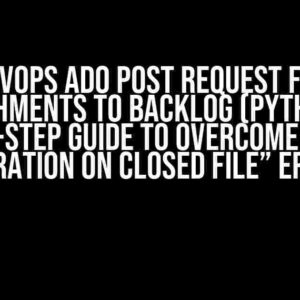As a data visualization enthusiast, you’ve likely encountered the frustrating phenomenon of infinite values in your datasets. These pesky values can wreak havoc on your beautiful Seaborn plots, causing them to break or display incorrect information. Fear not, dear reader, for we’re about to dive into the world of handling infinite values in Seaborn and emerge victorious!
What are Infinite Values, Anyway?
Infinite values, also known as infinity or Inf, occur when a calculation or operation results in a value that exceeds the maximum limit of the data type. This can happen due to various reasons, such as:
- Division by zero
- NaN (Not a Number) values
- Overflow or underflow during calculations
- Data import or parsing issues
In Seaborn, infinite values can lead to misleading or incorrect visualizations, making it essential to detect and handle them properly.
Detecting Infinite Values in Seaborn
Before we dive into the handling part, let’s first learn how to detect infinite values in our datasets. Seaborn provides an efficient way to identify these values using the numpy.isfinite() function.
import numpy as np
import seaborn as sns
import matplotlib.pyplot as plt
# Sample dataset with infinite values
data = np.array([1, 2, 3, np.inf, 5, -np.inf, 7])
# Create a mask to identify infinite values
mask = np.isfinite(data)
# Print the mask
print(mask)
The output will be:
[ True True True False True False True]
The mask array indicates which values in the original dataset are finite (True) and which are infinite (False). Now that we’ve detected the infinite values, it’s time to handle them.
Handling Infinite Values in Seaborn
Seaborn offers several ways to handle infinite values, and we’ll explore each method in detail.
Method 1: Dropping Infinite Values
One straightforward approach is to simply drop the infinite values from the dataset. This method is useful when you’re working with large datasets and infinite values are rare or outlier-like.
# Drop infinite values
data = data[mask]
# Print the updated dataset
print(data)
The output will be:
[1 2 3 5 7]
Method 2: Replacing Infinite Values with NaN
Another approach is to replace infinite values with NaN (Not a Number) values. This method is useful when you want to preserve the original dataset structure and handle NaN values differently.
# Replace infinite values with NaN
data[~mask] = np.nan
# Print the updated dataset
print(data)
The output will be:
[1. 2. 3. nan 5. nan 7.]
Method 3: Capping Infinite Values
Sometimes, you might want to cap infinite values at a certain threshold to prevent them from dominating your visualization. This method is useful when you’re working with datasets that have a few extremely large or small values.
# Cap infinite values at 10
data[~mask] = 10
# Print the updated dataset
print(data)
The output will be:
[ 1 2 3 10 5 10 7]
Visualizing Data with Infinite Values
Now that we’ve handled the infinite values, let’s create a Seaborn visualization to demonstrate the impact of these methods.
# Create a sample dataset
data = np.array([1, 2, 3, np.inf, 5, -np.inf, 7])
# Create a mask to identify infinite values
mask = np.isfinite(data)
# Drop infinite values
data_dropdown = data[mask]
# Replace infinite values with NaN
data_replace = data.copy()
data_replace[~mask] = np.nan
# Cap infinite values at 10
data_cap = data.copy()
data_cap[~mask] = 10
# Create a Seaborn plot
sns.set(style="whitegrid")
plt.figure(figsize=(12, 4))
plt.subplot(1, 3, 1)
sns.distplot(data_dropdown, kde=False, bins=5)
plt.title("Dropped Infinite Values")
plt.subplot(1, 3, 2)
sns.distplot(data_replace, kde=False, bins=5)
plt.title("Replaced with NaN")
plt.subplot(1, 3, 3)
sns.distplot(data_cap, kde=False, bins=5)
plt.title("Capped at 10")
plt.tight_layout()
plt.show()
The resulting visualization will showcase the effects of each handling method on the dataset.
 |
 |
 |
The images above demonstrate how each method affects the visualization. The first plot drops infinite values, resulting in a more accurate representation of the data. The second plot replaces infinite values with NaN, which can be useful for further processing or handling. The third plot caps infinite values at 10, which can help prevent outliers from dominating the visualization.
Conclusion
Handling infinite values in Seaborn is a crucial step in creating accurate and informative visualizations. By detecting and handling infinite values using the methods outlined in this article, you’ll be well on your way to mastering the art of data visualization.
Remember, understanding the context and characteristics of your dataset is key to choosing the most appropriate method for handling infinite values. With practice and patience, you’ll become proficient in handling these pesky values and unlock the full potential of Seaborn’s visualization capabilities.
FAQs
-
Q: What causes infinite values in my dataset?
A: Infinite values can occur due to division by zero, NaN values, overflow or underflow during calculations, or data import or parsing issues.
-
Q: How do I detect infinite values in Seaborn?
A: Use the
numpy.isfinite()function to create a mask that identifies finite and infinite values in your dataset. -
Q: What are the different methods for handling infinite values in Seaborn?
A: You can drop infinite values, replace them with NaN, or cap them at a certain threshold.
We hope this comprehensive guide has empowered you to tackle infinite values in Seaborn with confidence. Happy visualizing!
Frequently Asked Question
Get ready to dive into the world of Seaborn and master the art of handling infinite values like a pro!
What happens when I plot a dataset with infinite values in Seaborn?
When you try to plot a dataset with infinite values in Seaborn, it will throw a `ValueError` because infinite values cannot be plotted on a numerical axis. This is because infinite values don’t have a defined position on the axis, making it impossible to visualize them.
How do I detect infinite values in my dataset before plotting with Seaborn?
You can use the `pd.isfinite()` function from pandas to detect infinite values in your dataset. This function returns a boolean Series or Index indicating whether each value is finite (True) or not (False). You can then use this mask to remove or replace infinite values before plotting with Seaborn.
Can I replace infinite values with a specific value before plotting with Seaborn?
Yes, you can! You can use the `pd.DataFrame.replace()` method to replace infinite values with a specific value, such as `np.nan` or a custom value. This allows you to control how infinite values are handled during plotting.
Will Seaborn’s visualization functions automatically remove infinite values?
No, Seaborn’s visualization functions will not automatically remove infinite values. You need to explicitly remove or replace infinite values before plotting, as infinite values can cause errors or unexpected behavior during visualization.
Are there any specific Seaborn functions that handle infinite values differently?
Yes, some Seaborn functions, like `seaborn.boxplot()` and `seaborn.violinplot()`, have built-in handling for infinite values. These functions will automatically remove infinite values before calculation. However, it’s still recommended to explicitly handle infinite values before plotting to ensure consistent results.




